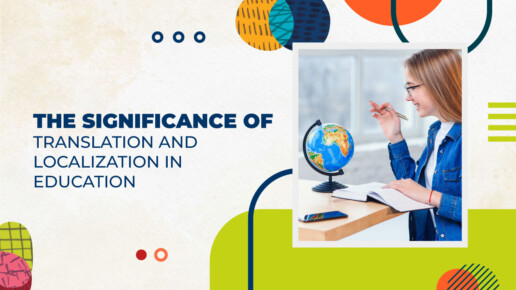The Significance of Translation and Localization in Education
In today’s interconnected world, the role of translation and localization in education cannot be overstated. As we break down the complexities of this vital aspect, it becomes evident that it goes beyond mere language adaptation—it’s about creating a seamless bridge between cultures, fostering inclusivity, and enhancing the overall learning experience.
Introduction
Definition of Translation and Localization
At its core, translation services involves rendering content from one language to another, while localization is the process of adapting this content to a specific cultural and linguistic context. In education, this dynamic duo plays a pivotal role in ensuring that knowledge transcends borders.
Importance in Education
The globalized nature of education requires a nuanced understanding of the importance of translation and localization. It’s not just about conveying information; it’s about making education accessible, irrespective of linguistic and cultural differences.
Bridging Cultural Gaps
Enhancing Cultural Understanding
Translation and localization serve as cultural ambassadors, fostering a deeper understanding among students from diverse backgrounds. By embracing different perspectives, education becomes a universal language that transcends cultural barriers.
Breaking Language Barriers
One of the primary challenges in education is the language barrier. Through translation and localization, we empower students to access educational materials in their native languages, ensuring that language is never a hindrance to learning.
Improving Learning Materials
Tailoring Content for Different Regions
Education isn’t one-size-fits-all. Tailoring learning materials to the local context ensures that students receive content that resonates with their cultural and societal nuances.
Adapting to Local Educational Standards
Localization goes beyond language—it adapts content to align with local educational standards, making the learning experience more relevant and effective.
Multilingual Communication
Facilitating Teacher-Student Communication
Translation facilitates seamless communication between teachers and students, breaking down language barriers and fostering a more engaging and interactive learning environment.
Fostering Inclusive Learning Environments
In an era of diversity, inclusion is paramount. Translation and localization contribute to creating classrooms where students feel seen, heard, and understood, irrespective of their linguistic backgrounds.
Global Collaboration
Connecting Educational Institutions Worldwide
Translation and localization enable global collaboration among educational institutions, fostering the exchange of ideas and best practices on an international scale.
Promoting Cross-Cultural Exchanges
Students benefit from exposure to diverse perspectives. Translation and localization facilitate cross-cultural exchanges, preparing students for a globalized workforce.
Technological Advancements
Role of Technology in Translation
The digital age has revolutionized translation and localization. Technology plays a crucial role in automating processes, ensuring efficiency, and expanding the reach of educational content.
Tools and Platforms for Education
Various tools and platforms leverage technology to make educational content accessible globally, highlighting the symbiotic relationship between education, translation, and technology.
Challenges in Translation and Localization
Maintaining Accuracy
One of the challenges in translation is maintaining accuracy, especially when dealing with complex educational content. Striking a balance between linguistic fluency and subject matter expertise is crucial.
Addressing Cultural Sensitivities
Localization requires a nuanced understanding of cultural sensitivities. Missteps in this area can lead to misinterpretations and hinder the effectiveness of educational materials.
Future Trends
Integration of AI in Translation
The future of translation and localization in education involves the integration of artificial intelligence. AI can enhance accuracy, speed, and scalability, paving the way for more sophisticated educational content.
Continuous Evolution of Educational Localization
As education evolves, so does the need for dynamic localization. Adapting to emerging trends and technologies ensures that translation and localization remain effective and relevant in the ever-changing landscape of education.
Case Studies
Successful Implementations
Exploring real-world examples of successful implementation provides valuable insights into the positive impact of translation and localization on education.
Lessons Learned
Analyzing case studies also allows us to learn from challenges and failures, refining our approach to ensure continuous improvement in educational localization.
Benefits Beyond Education
Impact on Global Business
The skills acquired through a globally focused education extend beyond the classroom. Translation and localization contribute to creating a workforce that is adept at navigating diverse global business landscapes.
Cultural Exchange beyond the Classroom
The influence of translation and localization goes beyond education, fostering cultural exchange and understanding on a broader societal level.
Conclusion
Recap of Key Points
In conclusion, the significance of translation and localization in education is multifaceted. From breaking down language barriers to fostering global collaboration, the impact is profound and far-reaching.
Future Prospects
As we look to the future, the integration of AI and the continuous evolution of educational localization promise exciting advancements, ensuring that education remains a universal right accessible to all.

